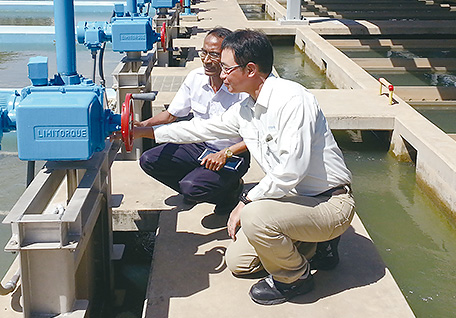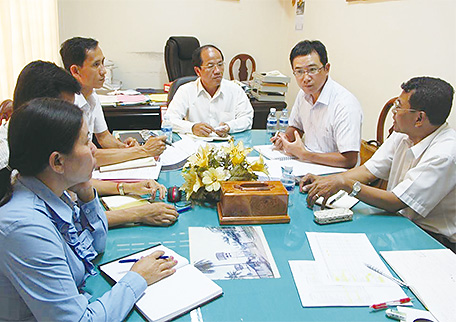Japan's Official Development Assistance White Paper 2013
Stories from the field 04
Bringing Infrastructure and Human Resources Together to Deliver Safe Water
– Support for Cambodia from the Kitakyushu City Water and Sewer Bureau –

Confirmation is made about the valve update plan with the manager in charge of water purification at the Phum Prek Water Treatment Plant in Phnom Penh. (Photo: Takayuki Kawasaki)
There are not many countries around the world where people have easy access to clean water through water faucets. Even in the urban areas of Cambodia, a country located on the Indochina Peninsula, access to safe water is possible for only 62% of the population.
During the period of civil war continuing on from the 1970s, the regime of Pol Pot destroyed much of Cambodia’s infrastructure. As a result, there are many regions without water and sewer systems, and there is a lack of the human resources needed for the management and operation of waterworks. To address such problems, Japan formulated a water supply master plan, and since 1993, Japan has been working to rebuild the country’s waterways together with the World Bank and Asian Development Bank (ADB). In 1999, the Kitakyushu City Water and Sewer Bureau started technical cooperation for the Phnom Penh Water Supply Authority (PPWSA). The PPWSA had already begun to install water pipes. Officials from the Kitakyushu City Water and Sewer Bureau proposed the introduction of a device for the remote management of water leaks and taught PPWSA officials about methods for waterworks management.
The Kitakyushu City Water and Sewer Bureau continued support even after that project was completed. The Bureau participated in a JICA project started in 2003, the “Project on Capacity Building for Water Supply System.” Thanks to the support, the PPWSA was able to realize 24-hour water supply with a low rate of leakage, a safe level of quality that ensures potable water, and a stable system for the collection of fees. The water system coverage rate in Phnom Penh used to be just 25% in 1993, but has now reached over 90%, while the rate of unaccounted-for water (UFW), a measure of the amount of revenue lost by waterworks due to leaks or thievery, has fallen dramatically from 70% in the 1990s to 6% today. These successes are being called the “Miracle of Phnom Penh.” In thanks, the Government of Cambodia even awarded the Mayor of Kitakyushu with the Grand Cross medal, an award of friendship. This medal is awarded in the name of the King of Cambodia to foreign nationals who contribute to friendly bilateral relations. The officials of the Water Bureau were also given an award of friendship, the Knight rank.
The project is currently spreading beyond Phnom Penh to support the waterworks of eight regional cities such as Siem Reap and Kampot. Chief Advisor on this project is Mr. Takayuki Kawasaki. He is an expert of the management department, and is working to foster the human resources that will be able to sustainably maintain the waterworks infrastructure built through the support so far.
“To be honest, when I took this post, I was shocked. At some of the regional water bureaus, they could not order the parts or chemicals needed for waterways maintenance even when they ran out. In order to provide the stable supply of needed goods, it is necessary to estimate the timing for purchases based on proper inventory management and secure a sufficient budget. Financial management using budget reports and financial statements is needed to this end. This is not just about waterworks skills – I really felt that if we didn’t improve the level of management capabilities here, they would not be able to manage a stable water system.”
The project implemented training programs in order to improve this situation. The officials of the PPWSA played an active part in this. With experience in realizing stable water supply management, they took up the job of training human resources in each of the eight regional cities. The Authority’s program has been highly evaluated throughout Southeast Asia, with requests currently said to be coming in from countries such as Nepal and Myanmar for new training programs.
Mr. Kawasaki aims to create a cycle among the eight regional cities such that the water bureaus that have learned management methods will be able to teach other bureaus that have not.
“It takes time to develop human resources. There are those among the waterworks officials here that feel extremely resistant to the efforts of the Japanese to negate the way things have been done up until now. But if they continue with their improper management methods, their system will eventually fail. Japan cannot continue this support forever. What is important here is that Cambodians organize their own training system. The realization of a stable water supply system requires both the maintenance of infrastructure and continued development of human resources.”
The Kitakyushu City Water and Sewer Bureau is expanding its support beyond Cambodia to Viet Nam and China. In 2010, the Bureau established the “Kitakyushu Oversea Water Business Association.” This association consists of 140 corporate members and works on initiatives to export Japan’s waterworks technology through routes pioneered by the Kitakyushu City Water and Sewer Bureau in countries like Cambodia.
Thanks to the trust forged with other countries through the international support given by the Kitakyushu City Water and Sewer Bureau, new business opportunities are now being created for the private sector.

Mr. Kawasaki confirms financial condition and offers guidance for improvement to the staff of the Kampot Water Supply Authority (second from the right) (Photo: Takayuki Kawasaki)
